Burdens of Tobacco Use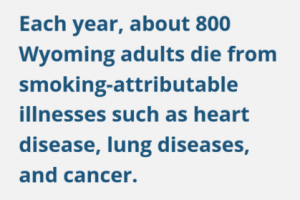
Economic Burdens
The death and disease caused by tobacco has economic costs. In 2010, tobacco-related healthcare cost Wyoming nearly $240 million, including private and public costs—more than alcohol and other drugs (Figure 19; WYSAC, 2012).
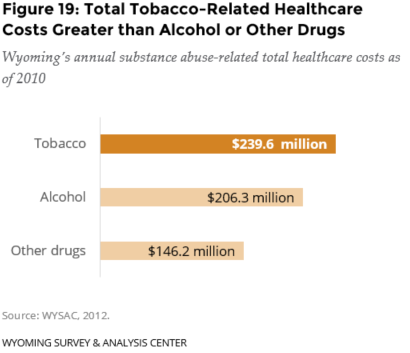 There are also less direct economic costs of tobacco use. Smoking is associated with lost productivity both nationally (USDHHS, 2015) and in Wyoming. Tobacco cost the state of Wyoming nearly $450 million in total productivity losses in 2010 (Table 6; WYSAC, 2012).
There are also less direct economic costs of tobacco use. Smoking is associated with lost productivity both nationally (USDHHS, 2015) and in Wyoming. Tobacco cost the state of Wyoming nearly $450 million in total productivity losses in 2010 (Table 6; WYSAC, 2012).
Workers who smoke are generally less healthy and more costly for employers. Employing smokers is also associated with increased property loss and occupational disease (USDHHS, 2015). Berman et al. (2013) estimated that, on average, it costs $5,816 more per year to employ a smoker than a nonsmoker. Smokers are more likely to be injured at work than nonsmokers (Craig et al., 2006; USDHHS, 2015). These costs could be reduced by employers if they implement smokefree air policies and/or offer their employees access to cessation services (and those smokers use those services to successfully quit).
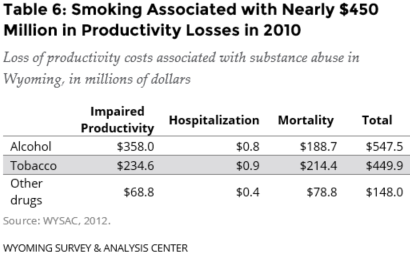 Tobacco-attributable health costs also affect the U.S. military and veterans. A history of smoking has been associated with increased risk of injury for men in U.S. Army basic combat training (Bulzacchelli et al., 2014). In 2010, smoking-attributable medical costs for the Veterans Health Administration were approximately $2.7 billion (Barnett et al., 2015). More broadly, the U.S. Surgeon General, surgeon general of the Air Force (Adams et al., 2019), the U.S. Navy and Marines (Adams et al., 2019; Navy and Marine Corps Public Health Center, n.d.) and U.S. Army (Adams et al., 2019; Army Public Health Center, 2019) have identified tobacco use as a threat to readiness of military personnel.
Tobacco-attributable health costs also affect the U.S. military and veterans. A history of smoking has been associated with increased risk of injury for men in U.S. Army basic combat training (Bulzacchelli et al., 2014). In 2010, smoking-attributable medical costs for the Veterans Health Administration were approximately $2.7 billion (Barnett et al., 2015). More broadly, the U.S. Surgeon General, surgeon general of the Air Force (Adams et al., 2019), the U.S. Navy and Marines (Adams et al., 2019; Navy and Marine Corps Public Health Center, n.d.) and U.S. Army (Adams et al., 2019; Army Public Health Center, 2019) have identified tobacco use as a threat to readiness of military personnel.
Health Burdens
Each year, an estimated 800 Wyoming adults die prematurely from smoking-attributable illnesses such as heart disease, lung diseases, and cancers (CDC, 2014a), an average of over two deaths per day. Each year, 480,000 people in the U.S. die prematurely from smoking or from exposure to secondhand smoke (USDHHS, 2015), an average of over 1,300 deaths per day. Tobacco use causes one in five deaths, more than the number of deaths attributable to alcohol, car crashes, suicides, AIDS, homicides, and illegal drugs combined (CDC, 2015a). Reducing deaths caused, in whole or in part, by tobacco use is the primary long-term goal of public health organizations working in tobacco prevention, including the TPCP and CDC. A related intermediate-goal is reducing the disease burden caused by tobacco use.
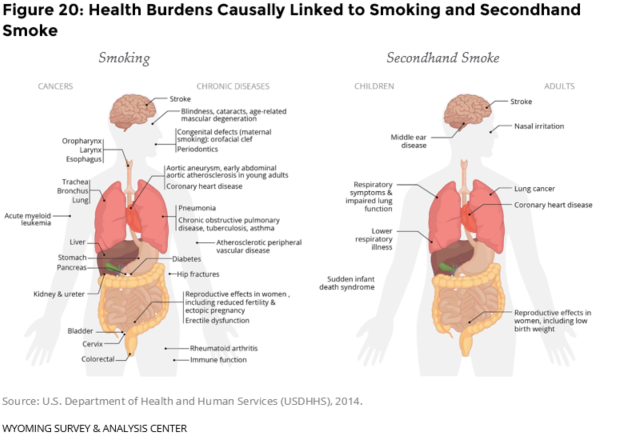
Chronic diseases are leading causes of death and sickness in the U.S. and Wyoming (Centers for Disease Control and Prevention, National Center for Health Statistics [CDC, NCHS], 2015). Smoking is the leading preventable cause of chronic disease and death in the U.S. (USDHHS, 2010). Although there is no safe level of exposure to tobacco smoke, greater exposure increases the risk for and severity of chronic disease. Cigarette smoke contains cancer-causing agents and chemicals that cause heart (cardiovascular) and lung (pulmonary and respiratory) diseases and contribute to poor reproductive and dental health. There are more than 7,000 toxic chemicals in cigarette smoke, including ammonia, tar, and carbon monoxide. These chemicals increase the risk for developing several preventable chronic diseases for smokers and those who breathe secondhand smoke (Figure 20; USDHHS, 2014).
Compared to Wyoming nonsmokers, current and former smokers were more likely to have been diagnosed with several chronic illnesses (Figure 21; WYSAC, 2018a):
- 5 times more likely to have been diagnosed with chronic lung disease,
- 8 times more likely to have heart disease,
- 7 times more likely to have diabetes,
- 4 times more likely to have cancer (other than skin cancer),
- 3 times more likely to have high blood pressure, and
- 2 times more likely to have high cholesterol.
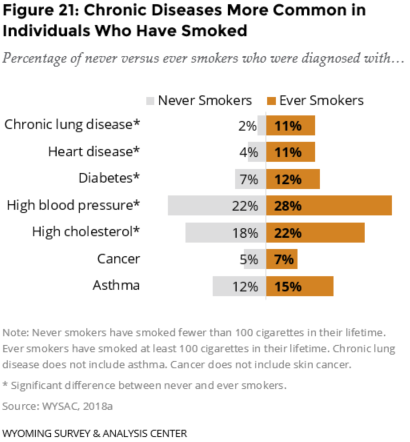
ENDS/e-cigarettes are a new tobacco product. Therefore, research on the contents of their liquid, aerosol, and health effects is limited. Long-term health effects of ENDS use are still unknown. However, research does shows that vaping harms lung function (Cressey, 2014). Early studies about the contents of the liquid and aerosol show the presence of varying levels of nicotine and cancer-causing chemicals such as formaldehyde (American Lung Association, 2016). Overdoses have been reported, including among children, from drinking the nicotine liquid or spilling the liquid on their skin (CDC, 2014b). The nicotine in most e-liquids is known to be addictive, can harm the developing brains of youth and young adults, and may make it more likely that youth will go on to develop other addictions (USDHHS, 2016). Labels on e-liquid have also presented inaccurate information about nicotine concentrations, meaning users might vape a nicotine-containing liquid contrary to their intention to avoid nicotine (Goniewicz et al., 2015). Aerosol from ENDS also contains chemicals linked to lung disease and heavy metals like lead (USDHHS, 2016).

